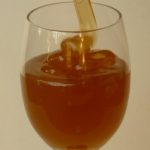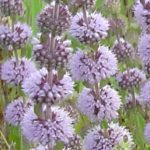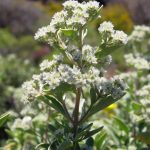Mint is a nectar producing plant with over 30 species and hybrids. Probably one of the best known herbs, it grows wild around the world and is widely cultivated. It is a member of the nectar-producing (melliferous) Lamiaceae family that include basil, oregano, rosemary, sage, thyme and lavender, many of which produce excellent single flower honey.
Mint honey is a rare treat. It has a strong flavor and distinctive aroma which varies depending upon the variety of mint it was made from. It is a common wild flower and is often a contributor to wild flower honey, but seldom in quantities sufficient to make a single flower honey. Fortunately, mint is cultivated for its essential oil and these large fields of mint make the monofloral variety of honey much easier to find. When looking for mint honey, start with the countries and regions known for producing the essential oil of mint.
Mint is generally known for its slightly sweet taste and the cool sensation it leaves in your mouth. It has been used for thousands of years as a culinary herb and for its aromatic and therapeutic properties. Mint is used for tea and therapeutic products and the essential oil of mint is used as an aromatic agent in chewing gum, dental products, pharmaceutical products, foods and drinks.
Mint is said to be named after the nymph, Minthe who was seduced by the Greek god of the underworld, Pluto. His wife, in a fit of jealous rage, trampled the nymph to dust. Pluto, unable to reverse his wife’s actions and save her, partly succeeded by turning her into mint, a plant that becomes even more aromatic if stepped upon. Mint was often strewn on floors as a natural air freshener that was revitalized as people walked on it.
Translations: Italian: miele di menta; French: le miel de menthe; Spain: miel de menta; Romania: miere de menta; German: minze honig; Croatia: Metvičin med
Peppermint Honey
Peppermint honey is a rare find these days in spite of the fact that mint it is widely cultivated. Peppermint (Mentha × piperita) is a naturally occurring hybrid mint, a cross between watermint (Mentha aquatica) and spearmint (Mentha spicata). It is found wild occasionally with its parent species. Peppermint honey crystallizes into a dense, fine buttery consistency, easily softened in warm water. It has one of the most powerful aromas of all the mints. Surprisingly, the honey does not taste like like what you might expect, peppermint candy. In fact, it has a strong musky aroma, which when combined with the menthol packs a powerful punch. The flavor is strong too, but it surprisingly good. It is medium sweet with a lingering after taste. It is a amber colored in liquid form and lightens to a beautiful caramel when crystallized.
The plant is a native of the Mediterranean and is cultivated in Japan, China, Australia and Great Britain. It is widespread in northern Italy, and particularly well known regionally as Mint Pancalieri (Torino). Peppermint honey found in Italy (Miele di Menta) is produced from these northern Italian Peppermint crops. United States is responsible for 75% of all world production. The history of mint agriculture in the United States began in the late 1700’s. It is cultivated on a large scale in the states of Oregan, Indiana, Idaho, Ohio and Michigan.
The ancient Egyptians, Greeks, and Romans used peppermint extensively in foods such as wines and meat and also in medicines. Additionally, it was used as crowns and decorations at feasts. Aristotle referred to it as a an aphrodisiac. In the eighteenth century, the peppermint was first utilized for commercial cultivation.
Peppermint aka: Balm Mint, Brandy Mint, Curled Mint, Lamb Mint
Translations: German: Pfefferminzhonig
Spearmint Honey
Spearmint – (Mentha spicata) Has a medium amber color and crystallizes easily. It has a medium strong aroma supported by a touch of menthol and a spearmint nuance. It is medium sweet with a short aftertaste.
One of the oldest recorded mints, it has long been used therapeutically for digestion and other illnesses. A native of the Mediterranean but is now also cultivated in the USA, UK, Italy, Yugoslavia, Hungary, Bulgaria, South Africa, Thailand, Vietnam as well as Argentina, Australia, Brazil, China, Egypt, France, Japan, Korea, Morocco, New Zealand, Paraguay, Romania, Russia, Taiwan. United States is a primary producer of spearmint oil with spearmint cultivation localized in the states of Indiana and Michigan. Spearmint honey may be found in both those states.
Pennyroyal Honey
Pennyroyal – (Mentha pulegium) 100 kg/ha honey; (Danube Delta – Romania). It is the tiniest of the mint plants. Pennyroyal honey is strongly flavored and works well with savory dishes. The name Pennyroyal is derived ultimately from the Latin, Pulegium (fleabane) as described by the ancient Roman naturalist, Pliny, for its ability to ward off fleas. It worked so well it was called Royal Fleabane, or in the original latin, “Pulegium regium” which was corrupted to, “Penny Royal” or Pennyroyal. It had such a strong aroma Pliny notes it was effective for reviving the fainted when stored in vinegar. It has an agreeable, strong pungent aroma comparable to camphor and similar to spearmint. Originating in France and Germany, it is found growing wild in Europe, Asia, New Zealand, North and South America and is cultivated in Morocco and USA. Pennyroyal honey may be found in New Zealand.
The name Pennyroyal is popular. There is another honey produced in the Canary Islands called “miel de poleo” which is tranlsated as Pennyroyal honey. It is produced from the nectar of “poleo de pinar” (Pine Tree Pennyroyal), a plant with a strong minty and menthol fragrance. This plant produces a similar tasting honey and belongs to the same family, Lamiaceae, but is an entirely different species, Bystropogon origanifolius. It is a rare plant found naturally only in the beautiful Canary Islands off the coast of Spain.
There is yet another Pennyroyal honey that was produced in Florida around the turn of the 20th century, and may be produced still, from the abundant Wild Pennyroyal or Florida Pennyroyal plant, of the same plant family Lamiaceae. However, this too is of an entirely different species, Piloblephis rigida (W. Bartram ex Bentham). This plant is only found naturally in Florida. In the book, The ABC and XYZ of Bee Culture, the honey is described as, “…clear, and light in color, perhaps the whitest of all honeys in the state, the body and flavor both being fine. Some Beemen here maintain that pennyroyal honey is the finest in the state…” (see reference below)
The plant was identified by the father and son naturalists, William and John Bartram in the late 1700’s. Coincidentally, these are the same naturalists who identified the plant source of Tupelo honey, Ogeechee Tupelo (Nyssa ogeche W. Bartram ex Marshall).
Translations: Spanish: miel de poleo; Italian: miele di mentuccia
Other Mints
Other mint honeys from around the world are obtained from wild or cultivated mint. A few popular ones are mentioned here. Availability of these honeys variable and possible only from local beekeepers selling directly or through local farmers markets.
- Corn Mint or Field Mint – (Mentha arvensis) (AKA पुदीना/ Pudina in Hindi, Wild Mint, Japanese Mint) is native to Europe and western and central Asia, east to the Himalaya and eastern Siberia, and North America. It is cultivated in India, China, Taiwan, Thailand, Japan and Brazil.
- Water Mint Honey – (Mentha aquatica) Grows in the Danube Delta – Romania. It is a native of Europe, northwest Africa (Morroco) and southwest Asia.
- Horse Mint Honey – (Mentha longifolia) Native to Europe, Western and central Asia, North and South Africa.
Peppermint blossom Image Credit: By H. Zell., Bergamot blossom Image Credit: By Magnus Manske, Pine Tree Pennyroyal Image Credit: By Tigerente. These image files are licensed under the Creative Commons Attribution-Share Alike 3.0 Unported license.
Wild Pennyroyal Image Credit: By Artcons
Specific chemical markers of Mentha species: The ester, Methyl syringate (MSYR) and vomifoliol. MSYR has been found in many monofloral honeys and is found in high concentrations in asphodel honey.
———————————————————————–
Refrences:
The ABC and XYZ of Bee Culture. An Encyclopedia Pertaining to Scientific and Practical Culture of Bees by Amos Ives Root, Ernest Rob Root Published in Medina, Ohio by the A.I. Root Company 1917 2nd Edition.









Where can I purchase Mint flavored honey in large quantities?
Hi Simon:
I would look to bee farmers in Indiana, the 4th largest producer of peppermint and spearmint in the United States. I have visited one such bee farmer in Northern Indiana. Most of his honey harvest was sold wholesale.
…Scott
Simon,
Where are you based as I have access to large quantities of mint honey in Europe and I am seeking a distributor.
Regards
Simon
We would like to buy several varieties of mint honey. We live in Lockport, NY. There are a lot of bee keepers in the surrounding area. Do you know where we might purchase in large quantities. Also, if you are still looking for a distributor, please contact me via my email. We do business with several business in which your products would go over very well. We are experienced distributors.
Thank you.
Hi Linda:
Thanks for reaching out. I do not sell honey myself, but perhaps a visitor with hives in mint country may be interested and respond here!
…Scott
Thanks, Scott. Do you know of any in our area of the woods, meaning Western NY? Also, where can I find grapefruit honey? I have not had it in a long time and it is so delicious!
Thank you.
Linda Ann
Hi Linda:
Peppermint processing and bottling had been in New York around Lyons from the late 1800’s t0 1990 by the H.G. Hotchkiss International Prize Medal Essential Oil Co. of Lyons. Most peppermint is now grown in Michigan and Indiana, and more recently to Oregon and Washington. That is were you should find mint honey production. Check with local beekeeper’s associations.
I have never had grapefruit honey. In fact it is rare to find any single flower (monofloral) citrus honey, as citrus fruits are usually grown together. In fact, even honey labeled as orange blossom honey is usually a mix of citrus blossoms. I have had what I believe was single flower orange honey from Sicily which was very delicious.
Do you recall where you found it?
…Scott